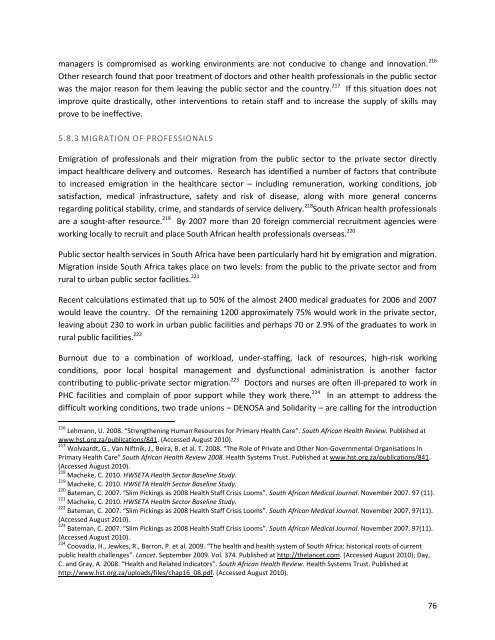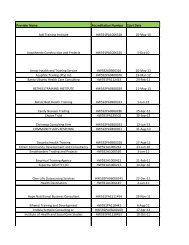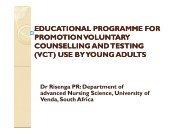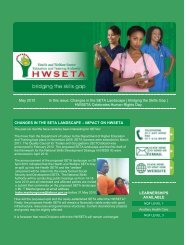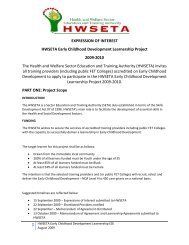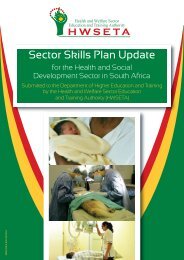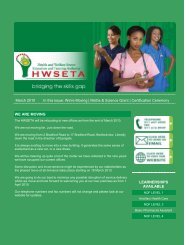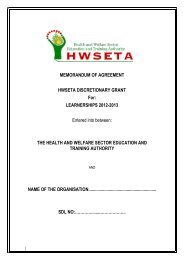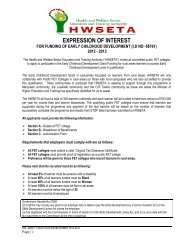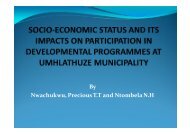sector skills plan for the health sector in south africa
sector skills plan for the health sector in south africa
sector skills plan for the health sector in south africa
Create successful ePaper yourself
Turn your PDF publications into a flip-book with our unique Google optimized e-Paper software.
managers is compromised as work<strong>in</strong>g environments are not conducive to change and <strong>in</strong>novation. 216<br />
O<strong>the</strong>r research found that poor treatment of doctors and o<strong>the</strong>r <strong>health</strong> professionals <strong>in</strong> <strong>the</strong> public <strong>sector</strong><br />
was <strong>the</strong> major reason <strong>for</strong> <strong>the</strong>m leav<strong>in</strong>g <strong>the</strong> public <strong>sector</strong> and <strong>the</strong> country. 217 If this situation does not<br />
improve quite drastically, o<strong>the</strong>r <strong>in</strong>terventions to reta<strong>in</strong> staff and to <strong>in</strong>crease <strong>the</strong> supply of <strong>skills</strong> may<br />
prove to be <strong>in</strong>effective.<br />
5.8.3 MIGRATION OF PROFESSIONALS<br />
Emigration of professionals and <strong>the</strong>ir migration from <strong>the</strong> public <strong>sector</strong> to <strong>the</strong> private <strong>sector</strong> directly<br />
impact <strong>health</strong>care delivery and outcomes. Research has identified a number of factors that contribute<br />
to <strong>in</strong>creased emigration <strong>in</strong> <strong>the</strong> <strong>health</strong>care <strong>sector</strong> – <strong>in</strong>clud<strong>in</strong>g remuneration, work<strong>in</strong>g conditions, job<br />
satisfaction, medical <strong>in</strong>frastructure, safety and risk of disease, along with more general concerns<br />
regard<strong>in</strong>g political stability, crime, and standards of service delivery. 218 South African <strong>health</strong> professionals<br />
are a sought-after resource. 219 By 2007 more than 20 <strong>for</strong>eign commercial recruitment agencies were<br />
work<strong>in</strong>g locally to recruit and place South African <strong>health</strong> professionals overseas. 220<br />
Public <strong>sector</strong> <strong>health</strong> services <strong>in</strong> South Africa have been particularly hard hit by emigration and migration.<br />
Migration <strong>in</strong>side South Africa takes place on two levels: from <strong>the</strong> public to <strong>the</strong> private <strong>sector</strong> and from<br />
rural to urban public <strong>sector</strong> facilities. 221<br />
Recent calculations estimated that up to 50% of <strong>the</strong> almost 2400 medical graduates <strong>for</strong> 2006 and 2007<br />
would leave <strong>the</strong> country. Of <strong>the</strong> rema<strong>in</strong><strong>in</strong>g 1200 approximately 75% would work <strong>in</strong> <strong>the</strong> private <strong>sector</strong>,<br />
leav<strong>in</strong>g about 230 to work <strong>in</strong> urban public facilities and perhaps 70 or 2.9% of <strong>the</strong> graduates to work <strong>in</strong><br />
rural public facilities. 222<br />
Burnout due to a comb<strong>in</strong>ation of workload, under-staff<strong>in</strong>g, lack of resources, high-risk work<strong>in</strong>g<br />
conditions, poor local hospital management and dysfunctional adm<strong>in</strong>istration is ano<strong>the</strong>r factor<br />
contribut<strong>in</strong>g to public-private <strong>sector</strong> migration. 223 Doctors and nurses are often ill-prepared to work <strong>in</strong><br />
PHC facilities and compla<strong>in</strong> of poor support while <strong>the</strong>y work <strong>the</strong>re. 224 In an attempt to address <strong>the</strong><br />
difficult work<strong>in</strong>g conditions, two trade unions – DENOSA and Solidarity – are call<strong>in</strong>g <strong>for</strong> <strong>the</strong> <strong>in</strong>troduction<br />
216 Lehmann, U. 2008. “Streng<strong>the</strong>n<strong>in</strong>g Human Resources <strong>for</strong> Primary Health Care”. South African Health Review. Published at<br />
www.hst.org.za/publications/841. (Accessed August 2010).<br />
217 Wolvaardt, G., Van Niftnik, J., Beira, B. et al. T. 2008. “The Role of Private and O<strong>the</strong>r Non-Governmental Organisations <strong>in</strong><br />
Primary Health Care” South African Health Review 2008. Health Systems Trust. Published at www.hst.org.za/publications/841.<br />
(Accessed August 2010).<br />
218 Macheke, C. 2010. HWSETA Health Sector Basel<strong>in</strong>e Study.<br />
219 Macheke, C. 2010. HWSETA Health Sector Basel<strong>in</strong>e Study.<br />
220 Bateman, C. 2007. “Slim Pick<strong>in</strong>gs as 2008 Health Staff Crisis Looms”. South African Medical Journal. November 2007. 97 (11).<br />
221 Macheke, C. 2010. HWSETA Health Sector Basel<strong>in</strong>e Study.<br />
222 Bateman, C. 2007. “Slim Pick<strong>in</strong>gs as 2008 Health Staff Crisis Looms”. South African Medical Journal. November 2007. 97(11).<br />
(Accessed August 2010).<br />
223 Bateman, C. 2007. “Slim Pick<strong>in</strong>gs as 2008 Health Staff Crisis Looms”. South African Medical Journal. November 2007. 97(11).<br />
(Accessed August 2010).<br />
224 Coovadia, H., Jewkes, R., Barron, P. et al. 2009. “The <strong>health</strong> and <strong>health</strong> system of South Africa: historical roots of current<br />
public <strong>health</strong> challenges”. Lancet. September 2009. Vol. 374. Published at http://<strong>the</strong>lancet.com. (Accessed August 2010); Day,<br />
C. and Gray, A. 2008. “Health and Related Indicators”. South African Health Review. Health Systems Trust. Published at<br />
http://www.hst.org.za/uploads/files/chap16_08.pdf. (Accessed August 2010).<br />
76


